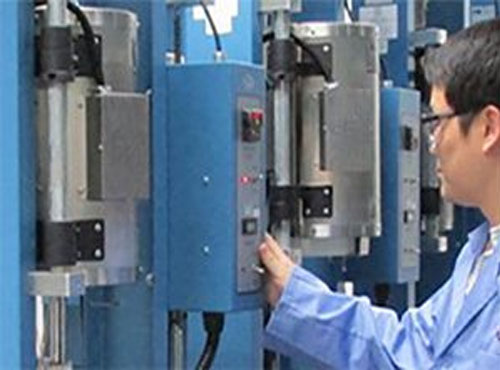
Creep and Stress Rupture
Creep and Stress rupture tests evaluate the ability of a part or material to safely hold a load, usually at in elevated temperature and sometimes humidity-specific environments.
Creep Testing measures the deformation of the material and the time it takes to rupture, Stress Rupture measures only the time it takes to rupture. These measurements are critical to manufacturers in a wide range of industries including aerospace and power generation, among others.
Creep and Stress Rupture Testing Capabilities
- Creep samples are tested at temperatures up to 1500ºF
- Stress rupture samples to 2100ºF
- Controlled relative humidity from 40% to 70%.
- Frames load capacity up to 12,000 lbs.
- Specimens single-point machined
- Low-stress grind available
- Full digital temperature and strain data logging
- Fast, accurate, measurable results
For more information on VARCHU MARC LLP creep and stress rupture capabilities, email us, or click on the button below to request information, or a quote.
MECHANICAL TESTING METHODS
- Abrasion (Taber)
- Adhesion (Peel) Testing
- Bend Testing
- Bond Strength Testing
- Charpy Impact Testing (-320°F to 450°F)
- Climbing Drum Adhesion of Sandwich Composites
- Coating Adhesion
- Coating Shear Fatigue
- Coefficient of Thermal Expansion by TMA
- Composite Testing (Fiber Reinforced)
- Compression Set
- Compressive Properties
- Core Shear Properties of Sandwich Construction by Beam Flexure
- Creep and Stress Rupture Testing
- DMA (Dynamic Mechanical Analyzer)
- Ductility
- Elastic Modulus
- Fatigue Testing
- Filled Hole Tension & Compression
- Flattening
- Flat-wise Tensile Testing
- Flexural Properties
- Floating Roller Peel Strength
- Fracture Mechanics
- Gel Time
- Hardness (Rockwell, Brinell, Durometer, Shore, Barcol, Knoop, Vickers, Macro Vickers)
- Heat Aging
- Heat Deflection by TMA
- Heat Treatment (furnace to 2100°F)
- Hydrogen Embrittlement
- Hydrostatic Pressure
- Indentation Toughness
- Interlaminar Shear
- Jominy Hardenability
- Lap Shear Testing
- Machining & Specimen Preparation
- Materialography
- Modulus of Rupture (MOR)
- n-Value (Strain Hardening Exponent)
- Open Hole Tension and Compression
- Pipeline Integrity Testing
- r-Value (Plastic Strain Ratio)
- Residual Strength of Composites After Impact
- Rotating Beam Fatigue
- Shear Testing of Rivets to ASTM B565, Single/Double
- Short Beam Strength
- Shot Peen Qualification
- Single-Edged Notched beams (SENB)
- Slow Strain Rate (G129)
- Specimen Conditioning
- Strain Gaging
- Surface Roughness (ANSI/ASME B46.1)
- T Peel Strength
- Tear Resistance of Films & Sheeting
- Tear - Rubbers & Elastomers
- Tensile Testing
- Torsional and Axial Fatigue (200 lb)
- Tube Testing (Tensile, Flare, Hydrostatic)
- Welder & Procedure Qualification
- Wire/Spring Testing (Wrap, Coil, Bend)
- Young's, Tangent and Chord Modulus (Room Temperature)
